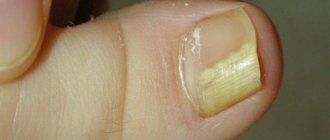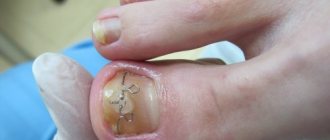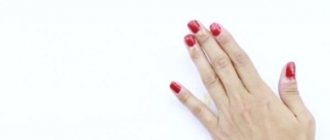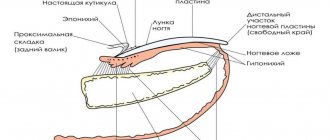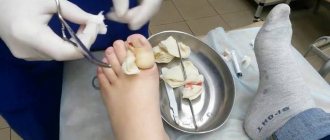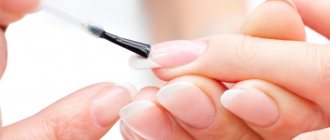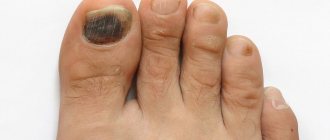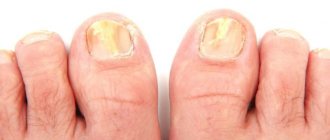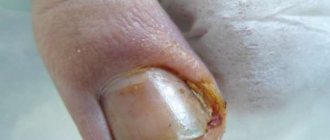What are wavy nails, their types
This deformation of the nail plates can occur in a person of any age and gender. Full article about deformation of fingernails.
The nails of the thumbs are most often affected.
As the pathology develops, the deformation spreads to other plates.
There are different types of wavy nails:
- longitudinal;
- transverse.
Longitudinal waves (vertical) are located from the cuticle to the edge of the nail. Such grooves are almost invisible on the nail plates; they can only be clearly seen at an angle.
The reasons for the appearance of small longitudinal waves are not very serious, they can be:
- mechanical damage during manicure,
- lack of vitamins,
- stressful situations,
- frequent contact with detergents.
Often such minor deformation of the nail plates appears after a person has suffered from some disease.
In such cases, the pathology disappears on its own some time after recovery.
The causes of strongly pronounced longitudinal grooves on the nails are already more serious. Usually, various diseases are diagnosed with such conditions of the nail plates.
| Transverse waves almost always indicate the presence of some problems with the body. This pathology has another name - Bo's furrows . |
Horizontal stripes on nails are usually more pronounced than longitudinal ones.
When the deformation of nails is accompanied by destruction and looseness of their tissue, as well as a change in the color of the plates, they speak of the development of a fungal infection.
In other cases, transverse waves on the nail plates may indicate the presence of diseases of varying severity in the body.
Main causes of wavy nails
There are several reasons for this pathology:
- Injury. Often felon (a purulent inflammatory process), a condition after a blow, damage during cuticle processing and other similar conditions lead to deformation of the nail plate, manifested in the form of its waviness. In such cases, you just need to wait until the healthy nail grows completely. If trauma situations occur regularly or in such conditions the matrix of the nail plate is affected, the unevenness may not disappear at all.
- Fungal infection of the nail plates (mycosis). Fungal infections are insidious because at the very beginning they affect the top layer of the nail. A person may not notice the first symptoms of the disease. Then, as it develops, damage occurs to the deeper tissues of the nail, deformation of the plate, and a disproportionate increase in its thickness - the appearance of waviness.
- Avitaminosis. Poor nutrition can also cause transverse waves to appear on the nails. For healthy formation and growth of nail plates, vitamins are required - mainly group B and vitamin A. The appearance of horizontal stripes is explained by a slowdown in the growth rate of the nail and its thinning during periods of vitamin deficiency. With adequate nutrition, the situation returns to normal. As these phases alternate, horizontal waves appear on the nail plates.
- Stressful situations. Usually in this state people develop “bad” habits: biting their nails, picking off hangnails. This leads to inflammation in the area of the periungual fold, injury to the nail plates, which can lead to their deformation.
- Changes in blood hormone levels. We are talking about a malfunction of thyroid hormones, since they are responsible for the health of the nail plates.
- Poor quality manicure. Often, independent treatment of nail plates leads to common mistakes: injury to the surface of the nails with sharp scissors, excessive filing, improper removal of the cuticle, which causes damage and inflammation of the periungual fold.
- Problems in the body. One of the main causes of wavy nails is systemic diseases. Usually, when stripes appear on the nail plates, diseases of the gastrointestinal tract, heart and blood vessels, thyroid gland, and reproductive organs are diagnosed.
Big toenails
On the feet, nail deformation is more common, since this area is more subject to mechanical stress and is more vulnerable to injury. However, the main risk in this case is that the damage may not be noticed immediately, which will complicate the treatment procedure.
Typically, the factors that can lead to a large nail bed are the same as on the hands.
However, several reasons can also lead to an increase in its size:
- Fungal infection. Infection of the foot is possible when visiting public showers, baths, and water parks without wearing shoes. The infection is accompanied by severe inflammation, which affects the quality of the entire pedicure.
- Wearing uncomfortable shoes. Girls often prefer tight high-heeled shoes that squeeze their feet tightly. Frequent wearing of them leads to damage to the fingers and changes in the direction of nail growth.
- Malignant tumor. It occurs most often on the legs. The appearance of large nails can be caused by improper personal hygiene, since the feet often come into contact with dirty floors, sweat, and the pores become clogged.
Treatment of wavy nails
When stripes and waves appear on the nail plates, it is necessary to first identify their cause , and only then determine a treatment strategy.
There are many factors influencing the deformation of nails, and it is unlikely that you will be able to recognize the true one on your own. It is necessary to consult a doctor to resolve this issue.
The specialist will conduct a full examination, prescribing the necessary tests. This will help determine the cause of wavy nails and select adequate treatment.
| The easiest way to get rid of deformation caused by mechanical damage . |
If the problem is a poor-quality manicure , you should seek help from an experienced nail technician. It is also necessary to properly care for your nails, treating them regularly, taking baths, and carefully pushing back the cuticles with an orange wood stick. How to properly do a manicure at home.
When treating your nails yourself, you must follow the following rules:
- manicure accessories must be treated with a disinfection solution before each procedure;
- manicure tools of high quality ;
- trimmed manicure should be performed using special manicure scissors, and burrs should also be trimmed with them;
- to remove nail polish you need to use special products, preferably without acetone;
- use moisturizing and nourishing creams containing vitamins.
It is useful to prepare various decoctions of herbs that have antiseptic and antimicrobial properties (chamomile, calendula and others), homemade paraffin wraps of nail plates . If you follow these rules, as your nails grow, the waves will completely disappear.
If trauma to the nail plate is caused by bad habits due to stress, the doctor may prescribe special medications to relieve nervous tension (Tenoten, Afobazol and others).
Prevention of waves on nails
To prevent any types of deformation of the nail plates and maintain them in a healthy condition, the following conditions must be observed:
- When doing a manicure, file your nails strictly at a right angle, do not tear off hangnails, and do not pull out the cuticle until bruising and inflammation appear;
- Due to the fact that nail plates can absorb everything from their surface, it is necessary to prevent their contact with household chemicals, high humidity,
- Wear gloves while working around the house,
- Take a break between coats of varnish;
- You should regularly apply nourishing products to your nails: oils, creams, make baths to improve their health;
- If you lack the skills to do a manicure only in a salon setting with experienced professionals;
- Always apply a base coat under the main coat of varnish;
- Monitor general health and promptly treat all diseases;
- Provide adequate nutrition.
If you follow these recommendations, your nails will stop breaking, peeling and deforming.
Detachment of the nail plate: reviews
Below you can read reviews from patients with detachment and deformation of the nail plate.
Detachment of the nail plate, reviews:
Olga, 25 years old. After switching to fall shoes, I forgot to cut my toenails. As a result, the nail on my big toe began to peel off and hurt. I came to my pedicurist, she advised me to remove the nail that had come off the skin. She carefully cut it off for me and restored the piece using gel. After 3 months, the nail has completely grown back. Periodically, once every 3 weeks, I came for a pedicure. The technician removed the artificial turf and cleaned the area that was empty so that nothing would get there.
Vika, 30 years old. I have longitudinal stripes on my nails, and this has nothing to do with the gel polish. After removing the artificial material, when a new nail grew, longitudinal stripes still appeared. I took a general blood test at the clinic, and it turned out that my hemoglobin level was very low. I took the drug Maltofer, and after six months my nails were completely restored and became perfectly smooth.
Irina, 45 years old. Lumps on the nails appeared after visiting the salon. I really regret that I went there, because I couldn’t make an appointment with my master. I got a fungus. I was treated for more than three months, and now my nails continue to grow. Now I will go exclusively to my master and not experiment. Antifungal drugs, as well as smart enamel, helped me restore my nails.
tubercles
- You will also be interested in the article “How to distinguish fungus from psoriasis: signs”
- By the way, we invite you to read an article about cases when fungal diseases, and sometimes injuries, cause detachment of the nail plate - “Onycholysis: how to treat and prosthetically?”
- You can read more information in our article “How to treat fungus?”
- You will also be interested in the article “Fungus after extension: what to do?”
